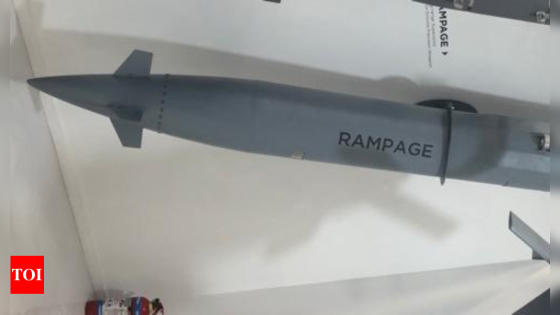NEW DELHI: The Indian Air Force has bolstered its fighter aircraft fleet with the induction of Rampage long-range supersonic air-to-ground missiles capable of targeting objects approximately 250 kilometers away.
Referred to as the High-Speed Low Drag-Mark 2 missile within the Indian Air Force, this weapon was also predominantly utilized by the Israeli Air Force during recent operations against Iranian targets.
The Indian Air Force has integrated the Rampage missile into its Russian-origin aircraft fleet, including Su-30 MKI and MiG-29 fighters, as well as Jaguar fighter jets, according to defense sources. The Indian Navy has also integrated the missile into its fleet for MiG-29K naval fighter jets.
This weapon provides Indian fighter pilots with the capability to engage and eliminate targets such as communication centers or radar stations.
The procurement of the Rampage missiles was a part of emergency powers granted by the defense ministry to the armed forces, following the 2020 standoff with China, aimed at ensuring the armed forces are equipped with critical weaponry and equipment.
Compared to the Spice-2000s used in the 2019 Balakot air strikes, these missiles boast a longer range. The Indian Air Force has pursued the acquisition of multiple weapon systems, including long-range systems from both international and domestic vendors.
Recent tests conducted by the Indian Air Force included the ROCKS or Crystal Maze-2 missile trials in the Andaman and Nicobar Islands territory, where the air-launched ballistic missile successfully hit its designated target approximately two weeks ago.
The integration of Rampage missiles with Russian Su-30 aircraft will further enhance the Russian aircraft fleet, enabling the firing of multiple long-range air-to-ground missiles, including the BrahMos supersonic missiles with a strike range exceeding 400 kilometers.
The Indian Air Force is further contemplating the possibility of producing Rampage missiles under the Make in India program and subsequently integrating them in the fleet.
(With agency inputs)
Referred to as the High-Speed Low Drag-Mark 2 missile within the Indian Air Force, this weapon was also predominantly utilized by the Israeli Air Force during recent operations against Iranian targets.
The Indian Air Force has integrated the Rampage missile into its Russian-origin aircraft fleet, including Su-30 MKI and MiG-29 fighters, as well as Jaguar fighter jets, according to defense sources. The Indian Navy has also integrated the missile into its fleet for MiG-29K naval fighter jets.
This weapon provides Indian fighter pilots with the capability to engage and eliminate targets such as communication centers or radar stations.
The procurement of the Rampage missiles was a part of emergency powers granted by the defense ministry to the armed forces, following the 2020 standoff with China, aimed at ensuring the armed forces are equipped with critical weaponry and equipment.
Compared to the Spice-2000s used in the 2019 Balakot air strikes, these missiles boast a longer range. The Indian Air Force has pursued the acquisition of multiple weapon systems, including long-range systems from both international and domestic vendors.
Recent tests conducted by the Indian Air Force included the ROCKS or Crystal Maze-2 missile trials in the Andaman and Nicobar Islands territory, where the air-launched ballistic missile successfully hit its designated target approximately two weeks ago.
The integration of Rampage missiles with Russian Su-30 aircraft will further enhance the Russian aircraft fleet, enabling the firing of multiple long-range air-to-ground missiles, including the BrahMos supersonic missiles with a strike range exceeding 400 kilometers.
The Indian Air Force is further contemplating the possibility of producing Rampage missiles under the Make in India program and subsequently integrating them in the fleet.
(With agency inputs)
Source Agencies



